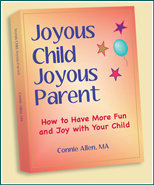As a young person growing up on a farm in rural Iowa, I lived in an area where many people “knew your business.” It’s a place where you could get a reputation if you stepped outside the box or if someone even suspected you had.
So I tried to fit in, even though I never really felt that I did. I tried to put on a good show so no one would know how isolated and lonely I felt. As you can imagine, this was incredibly restrictive and limiting to me, and , yes, I did get an undeserved reputation from people who had no idea who I was.
Fast forward to becoming a mom at 27 when I made a conscious choice to raise my son in a way that made sense to me. I had observed other parents relating with their children, and I had seen the limitations of the ‘usual approach.’
I wanted no part of it. I knew my son – all children – were much more than the adults around them realized. No more trying to fit in or not stand out as different.
I chose to focus on the two things that really mattered to me –
I wanted Orion to be who he was, not who society, the education system, or I wanted him to be. I wanted to support him in being his own person and living his truth. What I today call his Inner Brilliance.
I wanted to have a great relationship with him, where we were authentic, honest, and trusting with one another as people, not based on a traditional mother – son relationship.
These two priorities mattered more to me than anything, and I did my best to not let his room, schoolwork, friends, clothes, and other minor issues damage what mattered most.
If you ask Orion or I today, we will both agree these two priorities made all the difference as we continue to cherish our honest, loving relationship with one another.
Living outside The Box, parenting outside The Box requires two things:
1. The willingness and ability to think for yourself. To look around you with a questioning eye and to find your own way. Focusing on making your choices consciously and not simply going along with the crowd and fitting it.
2. The courage to trust your child and yourself. The courage to be seen as different and to stand out, most likely inspiring others to reconsider the choices they make as a parent. To be willing to fly in the face of authority and tradition, even when you’re scared and uncertain.
Now it’s your turn. What matters most to you as a parent? What are your highest priories for your child and yourself? I’m talking Big Picture things here. Not academic achievement or achievement of any kind. Not your fears or concerns. Dream big!
What do you really want to create / share / experience with your child?
Then let this be your guide. As you look at the day-to-day challenges, how can you honor your highest priorities as a person who is a parent and create a joyous, honoring relationship with your child?
************
An Invitation to join “Our Children’s Inner Brilliance Community’
Want to chose your highest priorities as a parent and learn how to stay focused on them through your day-to-day interactions with your child? This is exactly what we are going to talk about in our September Community Call on Saturday, September 27.
If you’d like to continue this exploration and discussion, I invite you to join ‘Our Children’s Inner Brilliance Community.’ where we explore this and other topics to nurture your child’s and your parenting Inner Brilliance.
This Community is for anyone – parents, grandparents, educators, concerned family and community members – who care about nurturing the Inner Brilliance of our children and who want to nurture them in being who they are.


 Just a little bit about me -- I'm a coach for parents, visionary guide, insightful trainer, and powerful consultant.
Just a little bit about me -- I'm a coach for parents, visionary guide, insightful trainer, and powerful consultant.